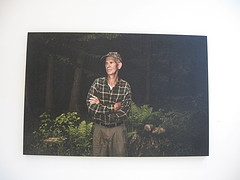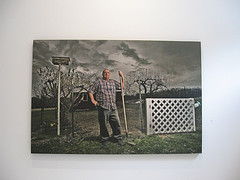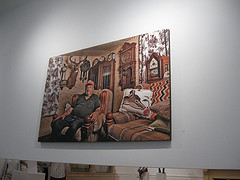
The careful attention to how the clothes are lit in Chris Crisman’s photos is one of the ways he makes his figures heroic
The photo portraits of post-WWII steelworkers hanging in at the FUEL Collection gallery intrigued me for so many of the choices photographer Chris Crisman made.
The series, part of his Titusville Steel Project, are large color prints, their size a statement of the respect Crisman gives to his subjects, all men of his father’s generation who worked in the local steel mill.

Even outdoor spaces feel airless in Chris Crisman’s photos of retired steelworkers
What makes these prints so unusual is the utter lack of irony in picturing blue-collar workers. They are presented with compressed sense of space, much like corporate portraits against cheesy power backgrounds. Even the outdoor spaces oppress, the big sky steel gray, lowering and weighty, the woods as close as a wall, looking like its right behind the subject.
Placing the men not just in their dens but in fields, in front of trees is another statement of their worth, of their heroic place in America, the Beautiful.

Crisman’s hero of the den
I could contrast them with David Graham, who often marvels at the quirkiness of individuals in the same, blue-collar class as Crisman’s subjects, but who stands apart from those subjects. In one of Crisman’s pieces, the crowded portrait in a claustrophobic paneled rec room (the pictures had no labels), a stocky man sits, proud and unjudged, trophies of his life and his taste arrayed in a way that proves his worth. This one had to be my favorite. Crisman does not marvel. He is coming home here.
The attention to the clothing is another sign of respect, the folds and drapes catching the light becoming elements of significance, symbols for self-worth for the man within.
I understand that in so many ways these portraits are utterly conventional, and yet I was quite taken with them. Their outlook is everything that is at odds with much of today’s art world. Maybe that’s why they looks so fresh to me.
Also showing at FUEL are papier mache no-threat monsters from Charlotte Daley and work I didn’t see by Maggie Chang, Eric Kephart and Michael Koehler (where was it?). I did see an anti-consumerist painting by Giappo Di Federico, who wasn’t listed as showing. The main thing I liked about this one was the irony of its location at FUEL, which, unlike most galleries, doesn’t bother to hide its sales mission. For more images, visit my Flickr set.





